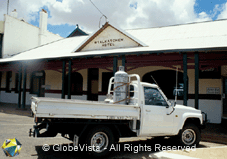Brief History
 Wyalkatchem is located in the Western Australian Wheatbelt, which is in the central agricultural region of W.A.
Wyalkatchem is located in the Western Australian Wheatbelt, which is in the central agricultural region of W.A.
The district was explored in 1864 but the first settlers to take up land in Wyalkatchem were in 1904.
The townsite was officially declared in 1908 and gazetted in 1911.
The Wyalkatchem shire covers an area of 1,743 sqkm with a population of approximately 620.
A railway was built in the 1900s but it only reached Korrelocking (a nearby town) with Wyalkatchem consisting of a few camps and a blacksmith. The railway was later extended in 1910, to include Wyalkatchem.
 The town was the first place to convert from bagged wheat to bulk wheat loading facilities, as the bagging process was costly and time-consuming.
The town was the first place to convert from bagged wheat to bulk wheat loading facilities, as the bagging process was costly and time-consuming.
The first trainload of bulk wheat departed from Wyalkatchem in 1931. Wyalkatchem originally had three of the five bulk loading facilities in Western Australia and is now known as the cradle of bulk loading in Western Australia’s Wheatbelt region.
The town’s economic survival depends on sheep and wheat, producing 56,000 tonnes of wheat and 896,500kg of wool annually.
How Wyalkatchem Got Its Name

There are several different stories and folklores surrounding the origin of the town’s name. One local legend claims the name was derived from a local trooper named C.E. Wylie, who supposedly had great tracking skills and became known as “CEWylie catchem” to the local Aborigines.
Another theory set out in the book “Araluen to Zanthus” was that the town was named after “Walkatching” an Aboriginal waterhole. The Toodyay Road Board in 1881 used the word “Walkatching” when referring to a tank to be placed at the Wyalkatchem townsite but when the tank was eventually marked they had spelled it Wyalkatchem.
Things You May Not Know About Wyalkatchem
During the 2020 Coronavirus pandemic, Wyalkatchem was named as the most vulnerable town in Western Australia. This was due to it having over 10% of its population (523) being over 80 years of age.
